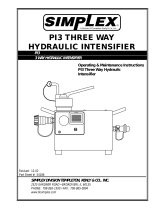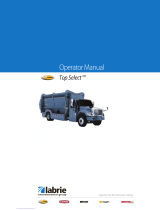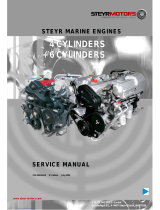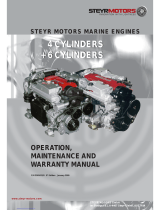
03/14
1
INSTRUCTIONS AND PARTS LIST FOR
42 Series Press for Models
500, 501, 502, 503
25 ton 50 ton 75 ton 150 ton
Elec-Draulic II Press
8-075 shown Elec-Draulic II
1809 Industrial Dr
Grand Haven, MI 49417

03/14
2
INSTRUCTIONS AND PARTS LIST FOR
Model 42 Elec-Draulic II Presses
WARNING LABELS
To the left is the safety Alert symbol. When you see these safety alert symbols on your press,
be alert to the potential for personal injury.
Follow recommended precautions and safe operating practices.
SETTING UP THE PRESS FOR OPERATION
For shipping convenience some of the parts may not be assembled.
NOTE: The press should set on a level floor with the base angles touching the floor at all
points. Use shims where necessary.
1. Motor starter box is mounted on right side of the machine. Have a qualified electrician connect power
to motor starter. Pump can rotate in either direction.
2. Oil Requirements: Fill reservoir thru street elbow at back of press with Mobil DTE oil No. 24 or
equivalent.
Model 25 ton uses 12 quarts 3 gallon
Model 50 ton uses 12 quarts 3 gallon
Model 75 ton uses 12 quarts 3 gallon
Model 150 ton uses 40 quarts 10 gallon
3. Attach nose piece to ram by inserting shank into ram and tightening the set screw.
CAUTION! Place the hoist crank on the lift drum shaft. Turn the hoist crank to relieve
the pressure on the table pins. Keeping tension on the hoist crank, remove the table pins one
at a time. After removing the tables pins, turn the crank running the table channels from top to
bottom. Check to make sure the cable is tracking correctly. The cable should be on each of
the two upper pulleys and should track back and forth on the cable drum. Always place table
pins under the table channels before releasing the hoist crank when positioning the table
channels for cable tracking, servicing, or set-up for desired work opening. If a tracking
problem exists, contact the Dake factory for instructions. Be sure all table pins are fully
inserted in place before applying pressure. Always remove or release pressure on the cable
before pressure is applied.

03/14
3
SAFEGUARDING THE POINT OF OPERATION
ANSI B11.2 – Hydraulic Power Presses
Safety Requirements for Construction, Care and Use
It is important that Dake press users have a clear understanding of their responsibility involving the care and use
of their Dake hydraulic press, including point-of-operation safe guards. Dake strongly recommends that Dake
press users obtain a copy of the current American National Standard Institute (ANSI) B11.2 standard, for a
more complete understanding of their responsibilities.
ANSI B11.2 states the following, relative to point of operation safeguarding:
“Normally, only the employer (press user) can determine the requirements of the press productions system
components, including the dies and methods for feeding. There fore, the employer is ultimately responsible to
designate and provide the point-of-operation safeguarding system”.
The standard also discusses additional responsibilities of the employer. Some of the key responsibilities are:
•The employer is responsible for the safety, use and care of the hydraulic power press production system.
•The employer is responsible to consider the sources of hazards for all tacks to be implemented on the
hydraulic power press production system.
•The employer is required to eliminate or control identified hazards in the scope of their work activity.
•The employer is responsible for the training of personnel, caring for, inspecting, maintaining and
operating hydraulic press production systems to ensure their competence.
•The employer is responsible to provide and ensure that point-of-operation safeguarding is used, checked,
maintained and where applicable, adjusted on ever production operation performed on a press
production system.
A complete and current copy of the ANSI B11.2 standard can be obtained by contacting the following:
American National Standards Institute
1430 Broadway
New York, NY 10018
AMT – The Association for Manufacturing Technology
7901 Westpark Drive
Mclean, VA 22102

03/14
4
OPERATIONS
WARNING: DO NOT OVERSTROKE THE RAM. Overstroking will cause premature seal failure.
Models 25 ton, 50 ton, 75 ton have a 10-inch stroke and the 150 ton has a 16-inch stroke.
The press has been completely tested at the factory and after setting up according to instructions above, the
press is ready for operation. However, it is necessary for the operator to acquaint themselves with the
controls.
1. The hand crank or ratchet on the hoist assembly is provided to raise or lower the table channels to
the proper work height. When desired height is obtained insert the table pins. The 25 ton and 50
ton models use 2 pins on each side (4 total). The 75 ton and 150 use 3 pins on each side (6 total).
After pins have been inserted, release pressure on cable by backing off with hand crank.
CAUTION: Be sure ALL table pins are in place an in as far as they can go before
pressure is applied. Be sure to slack off on the cable before pressure is applied.
2. The two table plates and two V-blocks are used for supporting the work in process.
3. Directional control valve is located on the right side of the press. This controls the diredtion of the
ram travel. There are three positions: Neutral (handle straight out), Ram down (handle pulled
down), Ram up (handle raised). The handle will return as soon as released by operator.
CAUTION: When first starting press after setting it up, run the ram up an down a few times to
work air out of the tube lines before putting pressure on ram. Avoid building pressure at the top
and bottom of the stroke.
4. The relief valve is located in the directional control valve block. It has been set at factory to open at
maximum tonnage of press. This setting should not be changed.
WARNING: Never exceed rated tonnage of press.
MAINTENANCE
CAUTION: When disconnecting any parts of this machine be extremely careful that all parts are
clean to prevent entrance of dirt in the hydraulic system.
1. If press looses pressure:
a. Check all tubing joints for leaks and tighten the tube nuts.
b. Trouble shoot Throttling 4 way valve.
c. Worn T-ring piston seal. If none of the previous conditions seem to havn been the cause of
pressure loss, the T-ring piston seal may be worn or damaged. To inspect this, it is necessary to
remove the work head assembly from the frame. Insert rod into the hole on piston guid and
unscrew from cylinder. Remove piston from cylinder. The T-ring seal can now be inspected and
replaced if necessary. Also at this time, inspection of rod seal and O-ring seal is recommended.
Replace if necessary. The work head can now be reassembled in reverse order bing careful not
to damage the T-ring seals and O-ring seal.
WARNING:
2. If press will not develop rated tonnage.
a. Relief valve set wrong. This valve is located in the lower left hand front corner of the manual
valve. The valve has been set at the factory to by pass oil from the pump back to the reservoir
when the pressure reaches rated capacity. To expose the relief valve for adjusting remove the
control handle ball, the control panel and the hex cap nut. The load on the spring which governs
the pressure at which the valve will by pass is adjusted by turning the adjusting screw clockwise
to raise the setting. Replace the hex cap nut, control panel and control handle ball after
adjusting. The relief valve should not be tampered with after it is once set at the capacity of the
press. NOTE: We advise that the relief valve not be tampered with after it is set at the
capacity of the press.
b. Trouble shoot 4 way vavle.
c. Worn ring – refer to section 1 (C) above.

03/14
5
3. If nothing happens when press is operated.
a. If motor does not run, the electrical circuit should be investigated.
b. If the ram will come down only a fraction of its rated stroke, check the oil level in the reservoir
with the ram at the top of its stroke.
4. If press is operating slow.
a. Improper oil. It is essential that the recommended oil (Mobil DTE 24 or equivalent) be used.
Heavier oils cause a marked reduction in the ram speed. NOTE: DO NOT USE HYDRAULIC
JACK OIL!
5. In case of damage to the pump or if pump will not perform properly refer to pump service instructions.
CAUTION: Adjustments to pump are not necessary and the pump should not be tampered with
because expensive repairs may result.
WARNING! High pressure fluid is present in operational hydraulic systems. Fluids under high
pressure are dangerous and can cause serious injury or death. Do not make modifications, repairs or
adjustments to any hydraulic system unless you are competent or working under competent
supervision. If in doubt, consult a qualified technician or engineer.
WARNING LABELS
To the left is the safety Alert symbol. When you see these safety alert symbols on your press,
be alert to the potential for personal injury.
Follow recommended precautions and safe operating practices.
Carefully read all safety messages in these instructions and on your press safety signs.
Keep safety labels in good condition. Replace missing or damaged safety labels. This machine is intended
to be operated by one person. This person should be conscious of the press ram movement not only for
himself but also for persons in the immediate area of the machine. Look over the safety labels. Be sure all
operators understand and follow all safety warnings.
CAUTION !!!!
Prolonged building of pressure at each end of the piston stroke may damage the work head.

03/14
6
84487
All pins must be inserted before applying any
pressure. Read instructions. Mount centered on
channel to right of table pins as shown.
84400
Guard workplace to prevent projectiles from
reaching operator. Mount ½” below stop
block or at eye level centered on flange as
shown
67881
Release table rollers before
applying pressure. Mount in
center of table channel as shown.
84399
Keep fingers out of pin holes. Mount
centered on channel to left of table pins as
shown.
84396
Keep hands away from point of operation
84401
Establish solid footing to prevent falls.
84395
High voltage.
76462
Lockout procedure

03/14
7
Parts list
See hoist parts list
Page 11
See work head
exploded view
Page 7
See Frame parts list
Page 11
See electrical parts
list Page 16
See hydraulic pump
exploded view
Page 12
See Frame parts list
Page 11

03/14
8
Work head exploded view
Item Part Name
Model
25 ton
Model
50 ton
Model
75 ton
Model
150 ton Qty
N Adaptor Flange 1067 1181 1400 2029 1
M Nose Piece 942 1150 3276 1987 1
L Piston 35811 35563 35575 35585 1
K Oil Seal 944 1477 1357 1524 1
J Piston Guide 34322 35562 35573 35592 1
H Teflon wear ring 37038 37045 37050 37055 2
G Palmetto ring 37054 1
F Cylinder flange 86610 35565 35593 83880 1
E Back-up washer 37040 37043 37049 37053 1
D O-ring 29637 37048 25823 1
C Teflon wear ring 37036 37041 37046 37051 2
B Palmetto Ring 37052 1
A Cylinder 34321 35561 35589 35584 1
N/A Complete assembly 707725 708077 708055 708078 1

03/14
9
Dynex Valve assembly Breakdown
Items 19,22,23,24
torque to 85 In lbs

03/14
10
Item Part Name
Part number
Qty
2-6 Pressure head repair kit one each of 2-6 54165 1
13 Grommet 47298 1
39 Handle 301328 1
41 Saddle 301329 1
48 Dual valve operating lever 301330 1
* Kit Valve segment unit repair kit, includes one each of items 25
and 30 thru 34, two each of items 14, 16, 18, 24, 26 and 28,
four each of 15 thru 17, 6 each of 13 67741 1 or 2
**Kit Segment replacement, includes one each of 19 thru 23, 25, 27,
30 thru 34, 41, 44 and 45, two each of 14, 16, 18, 24, 26, 28,
29, 37, 38, 42 and 43. 301735
*Note: 1 pc. For a 3 way valve (new 3way valve part number is 29661) These Dynex valves have all ½” NPT port sizes
2 pc. For 4 way valve (new 4 way valve part number is 29662)
** Note: This kit is completely assembled and pre tested and ready for service.
29662 Dynex valve replaces the Dake valve 26-300 and 26-302. Repair kit for the 26-300 is part number 710146. No repair kit
available for the 26-302.
29661 Dynex valve replaces the Dake valve 26-301. Repair kit for the 26-301 is part number 710146.
Note: If replacing a Dake valve with a Dynex valve, the port location may be different than the Dake valve.

03/14
11
Hoist breakdown
Item Part Name
Model
25 ton
Model
50 ton
Model
75 ton
Model
150 ton Qty
N/A Cable 45954 45954 726 726 17
N/A Cable clamp 583 583 991 991 4
19 Hand crank assembly 701653 701653 701653 701653 1
20 Worm shaft 742 742 1598 1598 1
21A Retaining ring 43982 43982 43992 43992 2
21B Retaining ring 43983 43983 43983 43983 2
22 Worm key 746 746 1602 1602 1
23 Worm 744 744 1600 1600 1
24 Hoist frame 739 739 1595 1595 1
25 Hex cap screw 43335 43335 43335 43335 3
26 Hex nut 43912 43912 43912 43912 4
27 Drum shaft 741 741 1597 1597 1
28 Drum key 745 745 1601 1601 1
29 Worm gear 743 743 1599 1599 1
30 Cable drum 740 740 1596 1596 1
N/A Ratchet handle assembly - - 75582 75582 1
Complete Table Hoist Assembly
(Items 20, 21A, 21B, 22, 23, 24, 27, 28, 29,30)
700111-S 700111-S 700104-S 700104-S 1
Figure 1

03/14
12
Table and frame part numbers
No picture available
Part Name
25
ton
50
ton
75
ton
150 ton
Qty
1 Pulley, Cable 1639 - - - 1
1 Pulley, Cable - 1639 - - 4
1 Pulley, Cable - - 1639 1639 4
2 Shaft, Cable Pulley 1641 1641 1641 1641 1
3 Block Stop 3/4x2x3-1/2” 1819 1819 1819 1819 8
4 Pin, Table 2256 2256 - - 4
4 Pin, Table - - 2256 - 6
4 Pin, Table - - - 1555 6
5 Shaft, Cable Pulley 2698 2698 1640 29510 2
6 Screw, Hex Cap ½ - 13 x 1-1/4” 43348 43348 43348 43348 8
7 Screw, Hex Cap ½-13x 3-1/4 43356 - 43356 - 8
7 Screw, Hex Cap ½-13x1-3/4 H300 43350 43350 - 43365 2
8 Screw, 3/4x10-1 ½ SHCS 43371 43371 43919 12
9 Screw, Soc Cap 5/16 – 18 x 3/4” 43433 43433 43433 43433 8
10 Screw, Soc Cap 3/8 – 16 x 1” 43449 43449 43469 43469 8
11 Screw, Soc Cap 3/8 – 16 1-3/4” 43452 43452 43452 2
12 Screw, Soc Set ½ -13 x ¾ cup pt. 43600 43600 43600 12
33 Lock Washer 3/8” 43645 - - - 10
33 Lock Washer ½” - 43647 - - 16
33 Lock Washer ½” - - 43650 - 12
33 Lock Washer 1” - - - - 24
13 Lock Washer ½” 43647 43647 43647 43647 16
14 Screw, Soc cap ½-13x3/4” 43648 43648 43648 20
15 Lock Washer, ¾ H300 43649 43649 43649 - 24
15 Lock Washer ¾” H300 - - - 43649 16
16 Nut, Hex ½-13 (Heavy) 43916 43916 43916 43916 8
17 Nut, Hex 5/8-11 (Heavy) 43917 43917 43917 20
17 Nut, Hex ¾-10 H300 - - - 43919 16
18 Nut, Hex Jam, 7/8-14 43947 43947 43947 43947 4
19 Ring, Retaining 43982 43982 43982 43982 6
20 Cable 45954 45954 24
20 Cable - - 45933 - 26
20 Cable - - - 45933 42
21 Clamp, Cable 583 583 1607 1607 4
22 Bearing, Camrol 60900 60900 60900 60900 4
22 - - - - 4
22 - - - 4
23 Clamp, Toggle 60901 60901 60901 60901 2
24 Block, Lifting 60903 60903 60903 2
25 Bracket, Clamp 63381 63381 60809 60809 2
26 Lever, Rolling Table 63382 63382 9928 64210 4
27 Channel, Rolling Table 63383 63383 - - 2
27 Channel, Rolling Table - - 60811 - 2
27 Channel, Rolling Table - - - 64214 2
28 Support, Rolling Table RH 63384 63384 60813 64458 1
28 - - - 1

03/14
13
28 - - - 1
29 Support, L.H. Rolling 63385 63385 60980 64459 1
30 Frame 65542 63386 60902 64457 1
31 Decal 67881 67881 67881 67881 1
32 Grease Fitting 44657 44357 44357 44357 4
33 Stop Bar, 1/4x2x6 64696 64696 - - 1
34 Screw, Drive 70277 - 70277 70277 6
34 Screw, Drive - 70277 - 2
35 Table Spacer 86486 86486 - - 4
35 Table Spacer - - 86488 1553 8
35 - - -
36 Table Plate 1534 2

03/14
14
THIS DIAGRAM IS FOR THE 25, 50 AND 75 TON MODELS
ONLY
Electrical parts list
Part # Part description Qty
302062 Starter enclosure 1
302187 Motor starter 220 volt 1
302189 Motor starter 440 volt 1
301382 Motor 2hp 1

03/14
15
150 ton model only
Part # Part description Qty
66490 Starter enclosure 1
70901 Motor 1
65649 Heater overload (150
ton only) 430 volt 3
66243 Heater overload (150
ton only) 230 volt 3

03/14
16
Part Name
25 ton
50 ton
75 ton
150 ton
Qty
1 Reservoir 36510 36510 36510 36527 1
1 Reservoir filter breather 29571 29571 29571 29571
2 Motor – electric 301382 301382 301382 70901 1
3 Pump 301756 301756 301756 29608 1
4 4 way valve w/relief valve 29662 29662 29662 29662 1
5 Work Head 707725 713717 708055 708078 1
6 Gauge 71270 71271 71272 71273 1
N/A Cylinder bore 3 5/8” 5” 6” 8” N/A
N/A Rod diameter 2 ¾” 4” 4 ¾” 6” N/A
N/A Stroke 10” 10” 10” 16” N/A
N/A PSI 4845 5100 5305 5970 N/A
N/A Piston Thread diameter ACME 1 ½ - 6 2 – 6 2 ½ - 4 3 ½ - 4 N/A
-
 1
1
-
 2
2
-
 3
3
-
 4
4
-
 5
5
-
 6
6
-
 7
7
-
 8
8
-
 9
9
-
 10
10
-
 11
11
-
 12
12
-
 13
13
-
 14
14
-
 15
15
-
 16
16
Dake 42-502 User manual
- Type
- User manual
Ask a question and I''ll find the answer in the document
Finding information in a document is now easier with AI
Related papers
Other documents
-
 Simplex PI3 - 54186 User manual
Simplex PI3 - 54186 User manual
-
 Labrie Top Select User manual
Labrie Top Select User manual
-
Buell Buell Blast P3 2001 User manual
-
 STEYR MO256K43 User manual
STEYR MO256K43 User manual
-
Buell Blast 2014 User manual
-
Buell 2005 P3 User manual
-
 Steyr Motors MO174V40 Operation, Maintenance And Warranty Manual
Steyr Motors MO174V40 Operation, Maintenance And Warranty Manual
-
Verbatim 43768 Datasheet
-
Buell 2006 P3 User manual
-
Buell P3 User manual



















